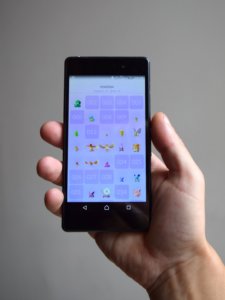 Smartphone adoption is rising. The number of smartphone users worldwide recently crossed 5.135 billion and shows no signs of slowing down. As Internet audiences continue to grow, mobile apps are projected to generate almost $189 billion globally by 2020.
Smartphone adoption is rising. The number of smartphone users worldwide recently crossed 5.135 billion and shows no signs of slowing down. As Internet audiences continue to grow, mobile apps are projected to generate almost $189 billion globally by 2020.
2018 was a great year for mobile app development. But it was really just getting us ready for 2019. What’s in store for 2019? Well, we’re glad you asked! Let’s take a look at the biggest trends coming up in the new year.
Send in the Chatbots
At our Los Angeles development HQ, we’re always excited to take on new projects in the chatbot market. Chatbots are forecasted to grow to $1.25 billion by 2025. It’s easy to see why: They’re great virtual assistants that satisfy modern business needs.
Studies show that up to 50% of B2B buyers prefer self-help options. And thanks to AI, integrating a chatbot into your app isn’t a tedious programming chore anymore. In 2019, chatbot personalization will become more sophisticated and streamlined.
An Accelerated Mobile Experience
Google’s AMP (Application Performance Management) pages result in faster, better experiences for mobile browser users (and as a result, better retention). In 2019, this technology will be central to better speeds and performance in apps.
2016 introduced instant apps, native mobile applications that don’t need to be downloaded; they’re smaller than regular apps, and they lower waiting times when first setting up a new phone. This convenient way to simplify installation will be a welcome trend in 2019.
The Convergence of IoT, Wearables, and Location-Based Technology
Wearables are forecasted to expand market penetration; experts say the fitness wearables market is projected to rise 64% by 2019.
Combining wearable devices and mobile apps with IoT and location-based tech will help to create a more holistic health and fitness experience. Expanding this field to IoT can bring in additional sensors and trackers to feed more multivariate data into the existing model.
And although most wearables are focused on health and fitness, developers have the freedom to create a solution for any problem they deem solvable with wearables. Beacon Technology uses GPS to get a user’s location and send them an automated, customized message. For example, when you walk into a store, your phone will vibrate and show you a coupon you can use at the register.
We look forward to seeing how location-based technology is implemented around us in the near future, whether it be at airports, during mobile payments, or custom beacons for your own home.
Augmented and Virtual Reality
AR and VR are projected to generate $200 billion in revenue by 2020. In 2019, we can expect to see these emerging technologies exert more influence over mobile strategies.

Hardware is getting better; more smartphone manufacturers are integrating dedicated AR and VR platforms into their devices. And with more intuitive development kits to navigate and utilize, software is getting better too. So it’s no surprise that developers are set to create unique, beautiful user experiences with AR and VR in 2019.
As in recent years, AR will most likely steal most of the spotlight due to its practical applicability to various scenarios that VR is not suitable for.
Artificial Intelligence and Machine Learning
Perhaps no other disruptive technology is impacting mobile app development more than AI. Today, integrating your app with machine learning (ML) has never been easier. And the benefits it offers are almost immediately realized.
ML and AI will particularly impact conversational agents like chatbots and virtual assistants in 2019. But that honestly doesn’t even touch the tip of the iceberg for the potential AI offers for business and consumers. Expect to see AI and ML implemented in novel ways this coming year.
Payments on the Go
Seamless and flexible payment systems are now expected by consumers from institutions; digital wallets and cryptocurrencies will continue to impact mobile app development in 2019.
There is a lot of potential for mobile blockchain applications in the next five years. And with e-commerce continually growing, mobile payment gateways will absolutely need to be secure, reliable, and convenient.
Integrating with the Cloud
If your mobile app developers don’t utilize the cloud to offload device wear and tear, you’ll want to make sure you’re including the cloud in your apps moving forward. With better storage options, loading times, and reduced hosting costs, the cloud can streamline the customer’s experience and the business’s operational workflow.
Research also shows that users are more likely to return to your app when an app uses the cloud.
Stronger Cybersecurity
Cybersecurity will become a big topic of discussion for many technologies and the industries in which they’re operating. In particular, mobile app data security is generally weak. Uber recently admitted to getting hacked, Facebook gave away user information without their explicit permission, and the EU recently fined Google $5 billion for Android anti-trust practices.
There’s clearly room for improvement. Hopefully, 2019 is the year industry leaders make it a priority.

Investing in cybersecurity can cost a lot up front, but it (obviously) costs more to replace your codebase and apologize to customers for losing their information. As consumers start prioritizing cybersecurity in their devices and software, mobile app developers cannot afford to fall behind in cybersecurity in 2019.
Predictive Analytics
Predictive analytics are being used to improve the user experience in apps for Facebook, Apple, and Google. A mobile app’s UI or UX can change depending on what predictions are made about your browsing behavior and interests.
This field will only get stronger with more data, so implementing predictive analytics, whether in your development workflow or in your actual app, can win you incremental improvements over time — which can become substantial, fast.
On-Demand Apps
The on-demand business model is growing beyond Uber, Postmates, and Seamless. In 2019, apps in this space will be enhanced by better UX/UI designs, predictive analytics, chatbots, and other technologies, like machine learning.
Even though it doesn’t seem like it can expand any further, this field will continue to grow and innovate new ways to bring us new services. And users will find that their feedback matters most for developers creating on-demand apps.
Your Imagination Is Your Only Limitation
2019 is the year for innovation in mobile apps. Many emerging technologies have evolved to the point that they’re ready for effective implementation. So this new year, creativity will be the name of the game for all involved with mobile apps.
What do you think is the most interesting mobile app development trend for 2019? Let us know in the comments below!





